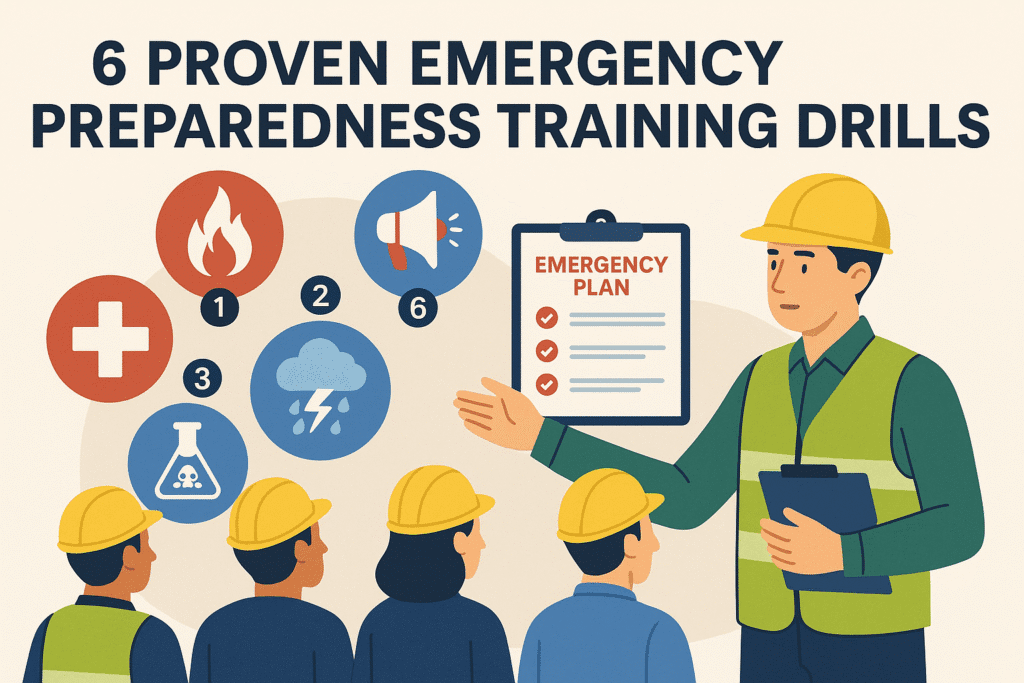
6 Proven Emergency Preparedness Training Drills for Any Industry
Emergencies don’t announce themselves. Whether it’s a fire, chemical spill, cyberattack, or natural disaster, every workplace must be ready. An effective emergency preparedness training program gives employees the knowledge and confidence to act quickly and correctly when the unexpected happens.
This article highlights 6 Proven Emergency Preparedness Training Drills that work in any industry. Each drill is designed to improve response times, clarify roles, and ultimately save lives.
Why Emergency Preparedness Training Drills Matter
- Life-Saving Response: Drills reduce panic and improve decision-making during real emergencies.
- Regulatory Compliance: Many jurisdictions (OSHA, ISO 22301, local fire codes) mandate regular drills.
- Business Continuity: Faster, coordinated responses minimize damage and downtime.
- Safety Culture: Demonstrates management’s commitment to employee well-being.
Drill 1: Fire Evacuation Drill
The classic yet most vital drill. Every workplace should practice:
- Recognizing fire alarm signals.
- Using primary and secondary evacuation routes.
- Gathering at designated assembly points.
- Accounting for all employees and visitors.
Best Practice: Conduct fire evacuation drills at least twice a year and vary the times to simulate unexpected conditions.
Example: A manufacturing plant adds obstacles to test employees’ ability to find alternate exits.
Drill 2: Medical Emergency Response Drill
Medical incidents can happen anywhere. This drill teaches:
- How to alert first aiders or emergency medical services.
- Location and use of first aid kits and AEDs (defibrillators).
- Basic CPR awareness for bystanders.
- Procedures for serious injuries or illnesses on-site.
Tip: Include scenarios like fainting, burns, or allergic reactions to keep employees prepared.
Example: Office workers practice calling emergency numbers and guiding paramedics to the scene.
Drill 3: Chemical Spill or Hazardous Material Drill
Any workplace storing chemicals — even cleaning supplies — should practice spill response:
- Immediate area evacuation or containment.
- Notifying the emergency response team or supervisor.
- Using spill kits safely (absorbents, neutralizers, PPE).
- Proper disposal and reporting after the incident.
Example: A laboratory conducts a mock spill of non-hazardous liquid to train employees on the spill kit procedure.
Drill 4: Active Threat or Security Lockdown Drill
Security incidents are increasingly part of emergency planning:
- Recognizing signs of an active threat or intruder.
- Locking doors, barricading, and staying out of sight if advised.
- Silent communication with authorities.
- All-clear signals and reunification procedures.
Tip: Coordinate with local law enforcement to make drills realistic but non-traumatizing.
Example: A corporate office practices shelter-in-place procedures for an unauthorized intruder scenario.
Drill 5: Severe Weather or Natural Disaster Drill
Depending on location, prepare for hurricanes, tornadoes, earthquakes, or floods:
- Identifying safe shelter areas or evacuation routes.
- Securing loose objects and shutting down equipment.
- Accounting for all personnel after the event.
- Communication plan with employees and families.
Example: A construction site near a coastal area runs a hurricane evacuation drill before storm season.
Drill 6: Communication and Business Continuity Drill
Many companies overlook communication during emergencies. This drill focuses on:
- Testing emergency notification systems (SMS, email, PA).
- Assigning roles for crisis communication and media inquiries.
- Ensuring backup systems and data recovery processes.
- Debriefing and documenting lessons learned after each drill.
Tip: Combine this drill with a tabletop exercise where managers simulate decision-making during a crisis.
Example: An IT firm simulates a data center outage and tests its crisis messaging to employees and clients.
Implementing Effective Emergency Preparedness Drills
To make these drills truly effective:
- Plan Ahead: Set objectives, scenarios, and metrics.
- Train Participants: Explain their roles before the drill.
- Execute Realistically: Simulate conditions without endangering anyone.
- Evaluate Performance: Debrief immediately and collect feedback.
- Update Plans: Incorporate lessons learned into policies.
Record Keeping: Maintain written records of all drills for regulatory compliance and continuous improvement.
Benefits of 6 Proven Emergency Preparedness Training Drills
- Improved Response Time: Employees know exactly what to do.
- Reduced Injuries and Damage: Quick action prevents escalation.
- Regulatory Compliance: Pass inspections with documented evidence.
- Boosted Confidence: Workers feel safer and more valued.
Key Takeaways
Emergencies are inevitable, but chaos isn’t. By practicing these 6 Proven Emergency Preparedness Training Drills, you can protect lives, minimize losses, and strengthen your safety culture across any industry.
Suggested Internal & External Links
- External: OSHA’s Emergency Preparedness
- Internal: 8 Critical Fire Safety Training Lessons to Save Lives
- 10 Must-Know Workplace Safety Training Topics for Every Employee
- 5-Step Proven Safety Training Plan to Reduce Workplace Accidents
- 7 Essential Safety Induction Training Modules for New Employees
- Crane, Lifting & Rigging Safety Training
Frequently Asked Questions
1. Why are emergency preparedness training drills important?
They equip employees to respond quickly and effectively, reducing injuries, property damage, and downtime during real emergencies.
2. How often should emergency drills be conducted?
At least annually, but high-risk industries or locations may require quarterly or semi-annual drills.
3. Should all employees participate in every drill?
Yes. While specific roles differ, all employees must understand the procedures and their responsibilities.
4. How do you measure the effectiveness of emergency preparedness drills?
By timing evacuations, checking communication systems, evaluating employee actions, and gathering post-drill feedback.
5. Can these drills be adapted for small businesses?
Absolutely. Even small workplaces can scale down scenarios while covering the same principles.